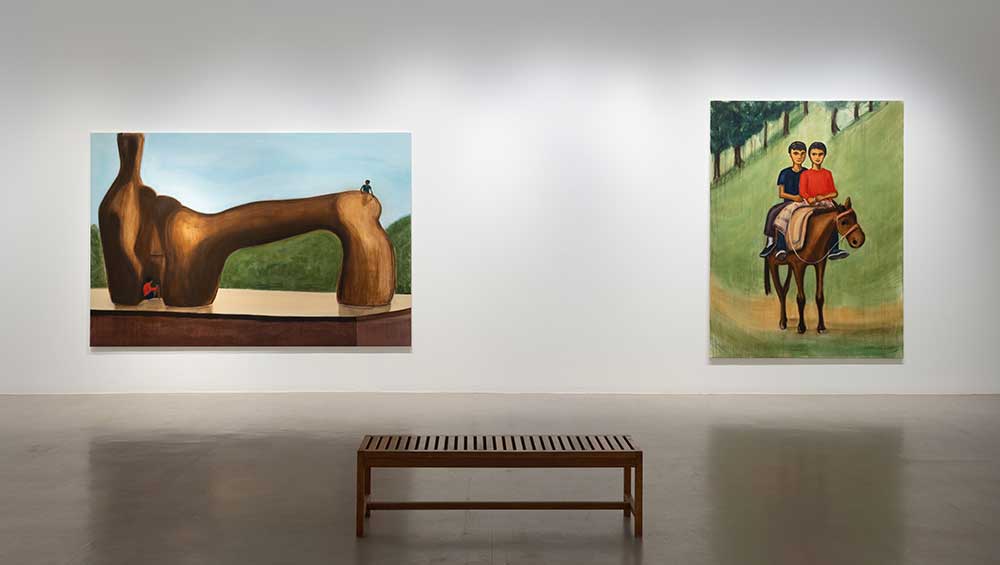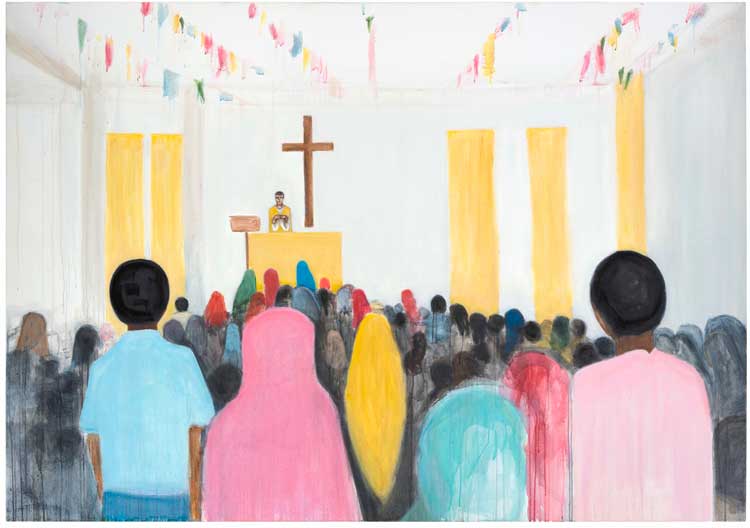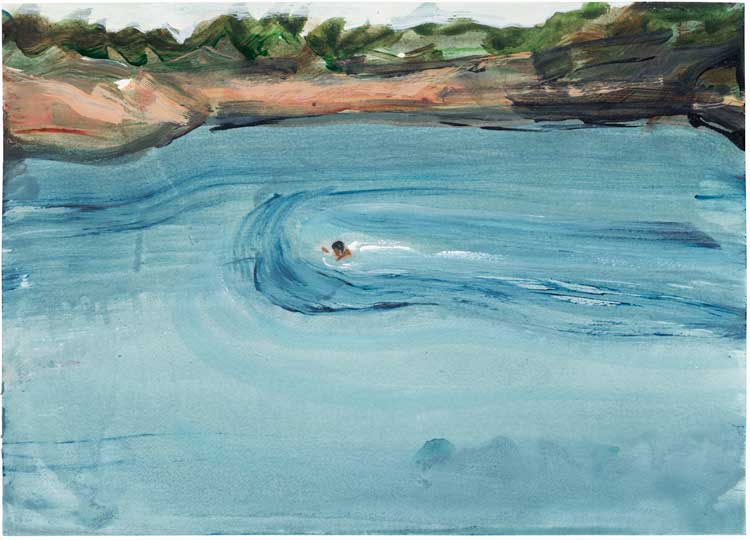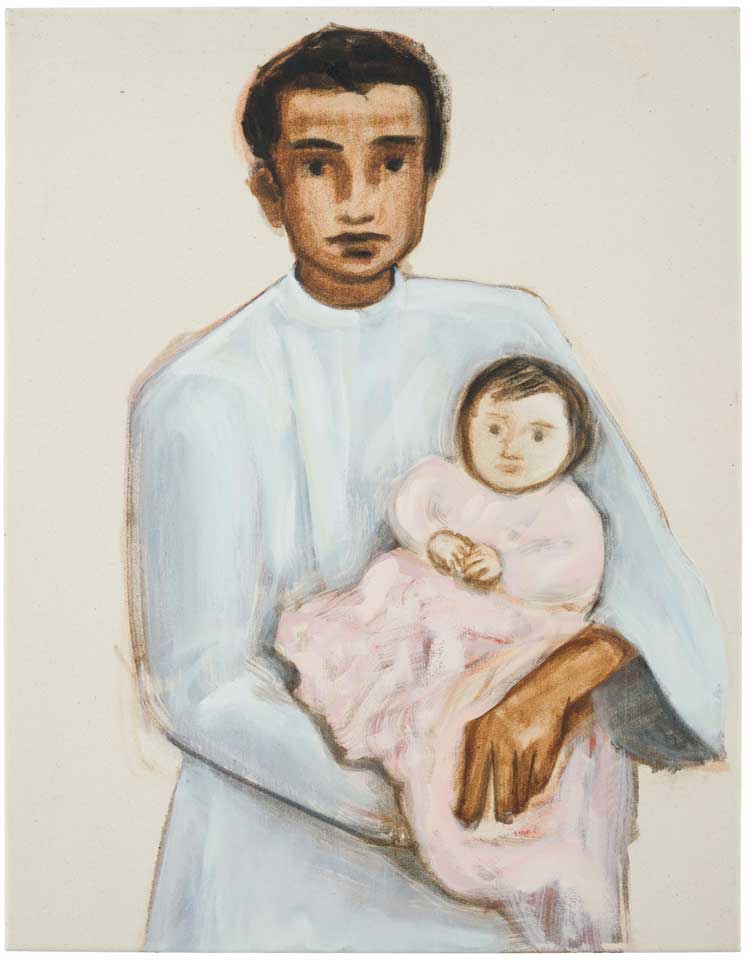
Installation view, Matthew Krishanu, The Bough Breaks, Camden Art Centre, London, 26 April – 23 June 2024. Photo: Rob Harris.
Camden Art Centre, London
26 April – 23 June 2024
by BETH WILLIAMSON
In this exhibition of new works and works on paper from the past 10 years, Matthew Krishanu (b1980, Bradford) creates a kind of holding space, or container, for memory, imagination and conversation. Put simply, he gives form to tenderness in heart-achingly beautiful pictures that put people and relationships at their epicentre. Atmospheric and pared-back compositions form this new exhibition – The Bough Breaks – hot on the heels of another – On a Limb – shown at Jhaveri Contemporary in Mumbai last year. Born in Bradford in the north of England, Krishanu grew up in Bangladesh, where his parents were Christian missionaries. The images presented here include scenes from his childhood that raise questions about race and religion, power and empire, and childhood itself.

Matthew Krishanu, Communion, 2017. Oil and acrylic on canvas. Private collection. Image courtesy of Tanya Leighton, Berlin & Los Angeles. Photo: Peter Mallet.
Krishanu’s paintings aren’t straightforward. Instead, they interweave memory and imagination with the history of painting. He references a wide range of sources – from Gwen John to Noah Davis; El Greco to the Ajanta cave paintings – all the time poking and prodding the western canon and its shaping of ideas about race and gender. Krishanu paints in series, including Another Country (2012-23), Mission (2012-23) and Holy Family (2016-23). One painting leads to another, as he constructs narratives that are at one and the same time deeply personal and universally relevant to what it means to be human.
The title of this exhibition (and his previous one) relates to the artist’s Two Boys series of paintings (part of his larger Another Country series) that show him with his brother, perched on the branches of a banyan tree, an important symbol in Indian culture. The network of limbs or branches suggests a safety net while the title, The Bough Breaks, gestures to the dark underbelly of the nursery rhyme Rock-A-Bye-Baby and thoughts of what would happen if the bough were to break. This direct allusion leads to another that is indirect – and all the more effective for that: the failure of contemporary society and the structures that should protect people within it.

Matthew Krishanu, Boy Swimming, 2023. Acrylic on paper. Image courtesy of Tanya Leighton, Berlin & Los Angeles. Photo: Peter Mallet.
Two ongoing series of works open the show – Another Country and Other Places (2016-23). Like a dive into deep water, then surfacing for air, these paintings explore Krishanu’s childhood in India, Bangladesh and Yorkshire in England. Here, he and his brother are shown in landscapes but, as the serial aspect suggests, these are not just pictures but stories. When you consider how Krishanu works, it is clear that his paintings are bound to be narrative in nature. His sources include family and found photos, mingled with postcards, newspaper clippings and images of works by other artists. From this ever-changing feast of images across time and space, a story emerges, and Krishanu can then select canvas or board, brushes and palette.
,-2024.jpg)
Matthew Krishanu, White Sari (Christ), 2024. Oil on canvas. Image courtesy of Jhaveri Contemporary, Mumbai. Photo: Peter Mallet.
Using a consistent portioning of paint means large paintings are thinly washed while smaller works are more thickly textured. It is a system that works well for Krishanu, and the thin wash or tint of larger works can be evocative of receding memories, like fading photographs, as Jennie Lomax (former director of Camden Art Centre) has previously suggested. Krishanu explains this strategy: “The colours in the paintings relate to the handling of the paint – in areas where the paint is thin and runny the colours appear as soft glazes; in areas that are more sculpturally built up the paint is more of a physical presence (often the figures themselves). I like to place figures within a landscape (or sometimes an interior) to give viewers an access point: to imagine themselves in a scene.”1
.jpg)
Matthew Krishanu, Sculpture Park (Two Boys), 2024. Oil and acrylic on canvas. Image courtesy of Niru Ratnam, London. Photo: Peter Mallet.
The figures in Krishanu’s landscapes may be solid enough, but the landscape they are situated in seems to dissolve around them, introducing a degree of uncertainty and disconcertion under the blue sky. In Skeleton (2014), two boys stand beside an animal skeleton that looks as if it might jump into movement at any moment. In Sculpture Park (Two Boys) (2024), the two miniscule figures of young boys play in and on a mammoth Henry Moore sculpture. The dark recesses of the underside of the sculpture, along with the shadows it casts, gesture to the dominance of western art histories and the dead white male artist, while simultaneously suggesting a more sinister landscape that might devour the boys at any point. The trailing, dripping banyan paintings are among the most hopeful and uplifting in the exhibition. Despite the precariousness of the tiny figures in Banyan (Boy) (2023), and Banyan (Two Boys) and Banyan (Girl) (both 2024), the sprawling network of branches, with their accessory trunks and aerial prop roots, remains supported and innovative in its search for life and sustenance, as well as providing food and shelter for other species.
,-2023.jpg)
Matthew Krishanu, Banyan (Boy), 2023. Oil and acrylic on canvas. Courtesy the artist. Photo: Peter Mallet.
Intimate domestic interiors such as Hotel Bed (Delhi) (2023) and Sofa (Two Boys, Cornwall) (2023) focus on just one or two figures and a single item of furniture (a bed or a sofa) that fills the picture space almost entirely. Floppy-limbed children, just home from outdoor play and still wrapped up against the weather, are exhausted, asleep with happy tiredness at each end of a comfy sofa. A figure (Krishanu’s late wife, the writer Uschi Gatward, who died in 2021) sleeps on her back, alone in a hotel bed. The covering of bed clothes registers the presence of the body beneath them, while an arm flops back beside the pillow that supports her head. In each instance, the bed or sofa engulfs the figure(s) but also acts to support and protect them. Asleep, we are at our most vulnerable, and yet there is a sense of safety in these pictures, the domestic as a haven or a refuge against the dangers of the outside world.

Matthew Krishanu, Priest and Baby, 2016. Oil on canvas. Courtesy the artist. Photo: Peter Mallet.
Another sort of interior is encountered in Krishanu’s Holy Family series and Mission paintings. Here, people of faith are shown not only as white European Christians, but Bengali Christian bishops, nuns and priests: Bishop’s Robes (2024), Four Nuns (2020) and Priest and Baby (2016). For the most part, Krishanu’s church interiors are densely populated, as in Blessing (2024), Preaching (2018) or Ordination (2017). Although we do see the congregation in Communion (2017), it is from behind. The painting’s focus is on the celebrant, with a golden glow pouring into the centre of the picture. Depictions of the artist’s parents sit alongside each other in this exhibition, too – his father a white English priest in the Church of Bangladesh, and his mother an Indian academic and theologian. Meanwhile, the pre-pubescent boys (Krishanu and his brother) frolic in idyllic landscapes bathed in blue sky. The point, however, is that it isn’t idyllic at all, that Krishanu’s paintings are shot through with a critique of patriarchy, colonisation and more. As the writer and broadcaster Bidisha Mamata sees it in her essay to accompany the exhibition, “These are family snapshots developed in acid and coloured with spiritual scepticism, fraternal bonding, familial claustrophobia, cultural displacement and paternalistic folly. The wary boys in the paintings look as if they’re waiting for the other shoe to drop – or the bough to break.”2 This may be personal for Krishanu, but this is contemporary life for many of us – fractured, sceptical, displaced. Through the lens of Krishanu’s childhood memories and imagination we are shown another way to tackle the instability and chaos of contemporary life – through family, through ritual (however flawed) and through nature. No perfect solutions, but critique, and choices. Nothing is lost forever.
References
1. Matthew Krishanu, cited in Matthew Krishanu: The Sun Never Sets, exhibition catalogue, Midlands Arts Centre, Birmingham, 2019, page 43.
2. Field Note 149: Matthew Krishanu by Bidisha Mamata, published by Camden Arts Centre, London, 2024.